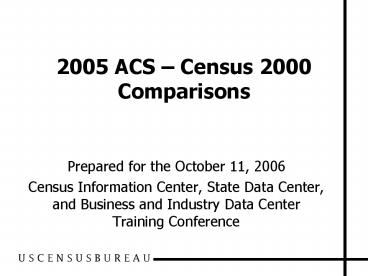2005 ACS Census 2000 Comparisons - PowerPoint PPT Presentation
1 / 25
Title:
2005 ACS Census 2000 Comparisons
Description:
College students living away at school? NO. Spring break vacationers in Fort Lauderdale? YES. College students living at home for the summer? ... – PowerPoint PPT presentation
Number of Views:102
Avg rating:3.0/5.0
Title: 2005 ACS Census 2000 Comparisons
1
2005 ACS Census 2000 Comparisons
- Prepared for the October 11, 2006
- Census Information Center, State Data Center, and
Business and Industry Data Center Training
Conference
2
What do you need to consider when comparing data
from the 2005 ACS with Census 2000 data?
3
Two factors to consider
- Interview and residence rules what is the
target population? - Time period and reference period what period of
time are the data describing?
4
ACS Target Population
- Housing unit population of the United States and
Puerto Rico - Current residents
5
ACS Target Population
- Whenever possible, compare household population
to household population - When you dont have estimates for the household
population for 2000, assess the likely impact of
the GQ population
6
Residence Rules
- Must work for all types of areas
- Must take into account changes in populations
over the course of the year
7
Goal of residence rules
- Resident of the sample address if a person
- Lives there year round
- Lives there more than 2 months but not year round
- Is living there now with no other place to live
- Is away now for 2 months or less
8
Goal of residence rules
- Not a resident of the sample address if a person
- Lives there 2 months or less with another
residence - Is away now for more than 2 months
9
Would the residence rules include
10
Would the residence rules include
11
- ACS data will describe a population similar to a
census usual resident population if the area - has a relatively stable population throughout the
year - includes seasonal populations who only stay for
short periods of time (2 months or less) - includes trivial numbers of long-term seasonal
populations
12
- ACS data will describe a population that differs
from a census usual resident population - if the area includes a large proportion of
long-term seasonal populations - if the population of the area changed
dramatically in the course of the year
13
What to expect in 2005
14
ACS produces period estimates
- They describe the characteristics of an area over
a specific time period - Contrast with point-in-time estimates that
describe the characteristics of an area on a
specific date
15
Weighted Census 2000 Sample 2000 ACS Housing
Units by Response Week
16
How do the reference periods used in the
questions on the ACS impact the interpretation of
results?
17
Reference Periods
- ACS uses the interview date as the single
reference point, or as the end of a reference
period, for all data collection - The Census 2000 sample did too, except for
income, migration, and agricultural sales
18
Questions with no specific reference period
- Most ACS questions do not stipulate a period of
time that should be referenced - Interpretation is yearly average since the data
are collected each month and averaged across
months
19
Questions with a specific reference period
relative to interview date
- Other questions specify a period of time relative
to the date of interview - Interpretation is still a yearly average but
covering a slightly different period of time than
the calendar year
20
So, what does all this mean about making
comparisons back to Census 2000?
21
Comparisons with Census 2000
- Four reports by Bureau staff compared single-year
data from the ACS with Census 2000 at national
level - Two staff reports and four reports by outside
researchers compared three-year averages from the
1999-2001 ACS test sites with Census 2000 at
county and tract levels
22
Comparisons with Census 2000
- Please refer to this website for results of these
comparisons and analysis of the differences
between the ACS and Census 2000 - www.census.gov/acs/www/advMeth/Reports
23
Its OK to compare when
- The target populations are the same or similar
- if tables include the same universe
- if areas have small GQ populations or
insignificant seasonal populations
24
Its OK to compare when
- The questions havent changed significantly or
the reference period is essentially the same
25
Questions?
- Deborah.H.Griffin_at_census.gov
- (301) 763-2855































